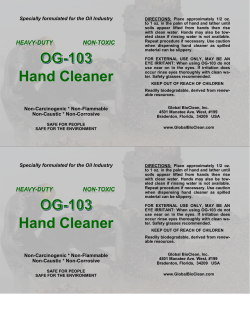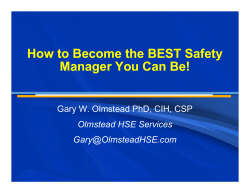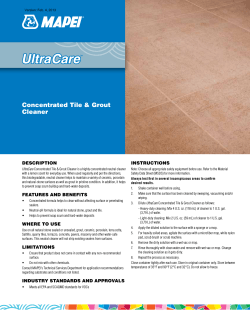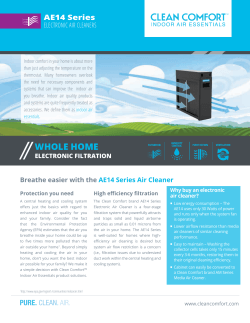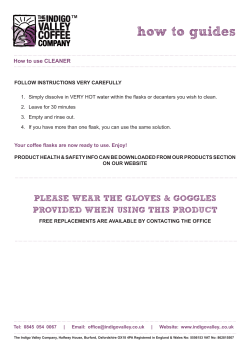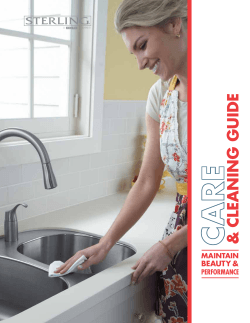
D O Y O U U S E ... S T E A M / W A T E... M A I N P R E C A... ●
INFORMATION AND TRAINING Companies who supply or hire out cleaners should provide enough information for operators to use them safely. Also, your employer should make sure that you are trained to use the equipment safely, and to understand the safe system of work. The future availability and accuracy of the references listed in this publication cannot be guaranteed. FURTHER INFORMATION Electrical risks from steam/water pressure cleanersGuidance Note PM29 (Second edition) HSE Books 1995 ISBN 0 7176 0813 1 M M AA II NN PP RR EE CC AAUU TT II O O NN SS ● ● Us Usee aa re ressiidu duaall ccuurrrreenntt ddeevvic icee ((RC RCD D)) oorr eeaarrtthh m moonniittoorriinngg ddeevviiccee,, wwiitthh cclleeaane n errss tthhaatt hhave ave fflleexxiibbllee ccaabblleess,, aanndd cchheecckk tthhat at iitt iiss wwoorrkkiing n g ddaaiilly.y. Provision and Use of Work Equipment Regulations 1998. DO YOU USE A S T E A M / WAT E R PRESSURE CLEANER? ● ● Approved Code of Practice and guidanceL21 (Second edition) HSE Books 1998 ISBN 0 7176 1626 6 HSE priced and free publications are available by mail order from HSE Books, PO Box 1999, Sudbury, Suffolk CO10 2WA Tel: 01787 881165 Fax: 01787 313995 Website: www.hsebooks.co.uk (HSE priced publications are also available from bookshops.) For information about health and safety ring HSE's CChheecckk fflleexxib ibllee ccaabblleess aanndd pplluuggss//ssoocckkeettss ddaaiillyy ffoorr vi vissiibbllee ssiiggnnss ooff ddaam maaggee aanndd ddoo nnoott uussee iiff ddaam maaggeedd oorr ffaauulltty.y. InfoLine Tel: 08701 545500 Fax: 02920 859260 Information Services, Caerphilly Business Park, Caerphilly CF83 3GG. You can also visit HSE’s website: www.hse.gov.uk YOU COULD ● ● e-mail: hseinformationservices@natbrit.com or write to HSE AAllwwaayyss wweeaarr eeye ye ppro rotteeccttiioonn dduurriinngg uussee.. This guidance is issued by the Health and Safety Executive. Following the guidance is not compulsory and you are free to take other action. But if you do follow the guidance you will normally be doing enough to comply with the law. Health and safety inspectors seek to secure compliance with the law This publication may be freely reproduced, except for advertising, endorsement or commercial purposes. First published 03/98. Please acknowledge the source as HSE. and may refer to this guidance as illustrating good practice. INDG68(rev) Reprinted 6/02 C200 BE IN FOR A SHOCK! D O Y O U U S E A S T E A M / WA T E R P R E S S U R E C L E A N E R ? Y O U C O U L D B E I N F O R A S H O C K ! F A U LT Y S T E A M / WA T E R P R E S S U R E C L E A N E R S K I L L P E O P L E E V E R Y Y E A R These machines make work areas wet. They may also make You should regularly check for any signs of damage to the you wet. Because of this, if you receive an electric shock from plug, splits or cuts in the cable sheath, or any slippage of the a faulty machine, it is more likely to be dangerous. Electric cable in the cable grip at either end. You should not be able Besides the checks that you make, someone also needs to shocks from this equipment can also cause serious burns. to see the brown, blue or green and yellow coloured wires carry out more detailed visual checks. Once a week is about Most shocks occur when electrical faults make the metal lance at the end of the flexible hose, or the machine’s casing, inside. Check this before you use the cleaner, or once a shift right if you use the cleaner daily. Someone needs to test the if it is in constant use. earthing and insulation of the cleaner every three months, or live. However, some shocks occur when people spray into You should also look for loose or broken covers over equipment that is still connected to an electrical supply. electrical parts. You could get a shock if water gets into the wrong parts of the cleaner. Report any faults that you find to a responsible person. ELECTRICAL SAFETY The safest way to use a cleaner is to fix it in one place, with permanent wiring to the supply. This is because the parts of cleaners that most often fail are the flexible mains cable and its connections to the plug and to the cleaner. MAINTENANCE more often if the cleaner is used on a construction site or similar workplace. The person who does this work may be the owner, a contractor, or an electrically competent person in your company. They may find it useful to keep a written record in a log book, to remind them when the next Remember that faulty cleaners can kill. Do not use a faulty maintenance is due, and to show any faults that keep steam or water pressure cleaner. occurring. Also, it is strongly recommended that a competent person tests the electrical installation to which you connect the cleaner. They should do this at least once a year, starting before you first use the cleaner. To prevent failures of flexible cables, try to route the cables away from the work area, and not across paths where they might get caught and pulled, or run over and damaged. This includes any extension cable, because it too will be most likely to fail at its connections at the plug and the socket. You should also make sure that there is a residual current device (RCD), or an earth monitoring device in the electrical supply to the cleaner. These devices will detect most dangerous failures and cut off the supply. NON-ELECTRICAL RISKS High pressure jets can force the fluid through the skin and this can be dangerous. No-one should stand in front of the cleaning jet. Also, the spray from your cleaner could drift into other work areas, or over other people, and this could be dangerous too. You should always wear suitable eye protection while the machine is working, and you may need special clothing such as wellington boots and waterproofs to protect you.
© Copyright 2025
